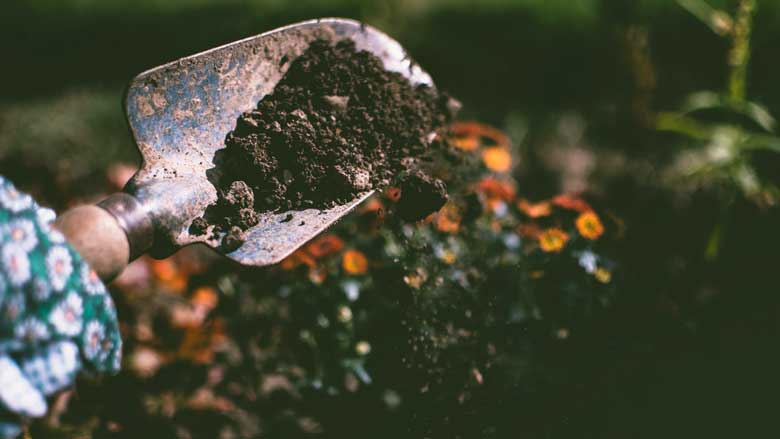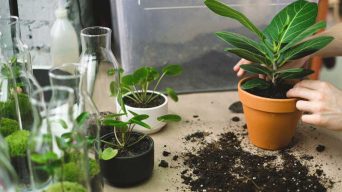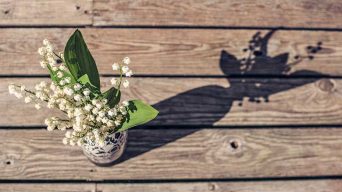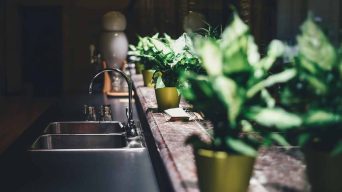When it comes to gardening, there are a lot of different opinions on the best way to do things.
Some people swear by using outdoor soil for indoor plants, while others say that it’s not a good idea and can cause many problems.
So which is right? Can I use garden soil for indoor plants?
And more importantly, what are the benefits and risks of using outdoor soil for indoor plants?
In this article, we’ll take a look at all the different aspects of using outdoor soil for indoor plants so that you can make an informed decision about what’s best for your garden.
What Is the Difference Between Outdoor and Indoor Soil?
Indoor plants need a different type of soil than outdoor plants.
Outdoor plants need soil rich in nutrients and can drain well, while indoor plants need soil that is more lightweight and has better moisture retention.
This is because indoor plants are grown in pots or containers, which means they can’t take advantage of the natural drainage that outdoor plants have.
The type of soil you use for your indoor plants is vital because it can affect the plant’s growth, health, and overall appearance.
If you use the wrong soil type, your indoor plants may not thrive and could even die.
What Are the Benefits of Using Outdoor Soil for Indoor Plants?
The main benefit of using garden soil for indoor plants is that it’s cheaper than buying potting mix or potting soil.
Outdoor soil is also easier to find than potting mix, which can be challenging to find in stores.
Another benefit of using outdoor soil is that it’s usually more organic than potting mix, which means it’s better for the environment.
What Are the Risks of Using Outdoor Soil for Indoor Plants?
However, some risks are associated with using outdoor soil for indoor plants.
Below, we’ll take a look at some of the most common risks:
Outdoor Soil May Contain Pests
One of the biggest risks of using outdoor soil for indoor plants is that it may contain pests.
Pests can cause many problems for your plants, including stunted growth, wilting, and even death.
If you’re going to use outdoor soil for your indoor plants, it’s essential to ensure that it’s free of pests.
The best way to do this is to sterilize the soil before using it.
Outdoor Soil May Spread Diseases
Another risk of using outdoor soil for indoor plants is that it may spread diseases.
Soilborne diseases can be very difficult to treat and can often kill your plants.
If you’re going to use garden soil for your indoor plants, it’s important to make sure that it’s free of diseases.
The best way to do this is to sterilize the soil before using it.
Outdoor Soil Is Often Too Heavy
Another problem with using outdoor soil for indoor plants is that it’s often too heavy.
Indoor plants need light, airy soil that drains well.
Outdoor soil is often too dense and can cause problems with drainage.
Indoor plants grown in heavy soil may not be able to get the oxygen they need, which can lead to root rot.
Potting soil is a better option for indoor plants because it’s light and airy. It also contains a variety of ingredients that help with drainage.
Outdoor Soil May Not Have the Right Nutrients
Outdoor soil may also not have the proper nutrients for your indoor plants.
Indoor plants need a different mix of nutrients than outdoor plants.
Garden soil often doesn’t have the right mix of nutrients that indoor plants need.
Using outdoor soil for your indoor plants may not get the nutrients they need and could become stunted or even die.
As a result, your plants may not thrive as well as they could if you used a potting mix or potting soil.
Outdoor Soil Retains Moisture for Too Long
Outdoor soil also retains moisture better than indoor soil.
This can be a problem for indoor plants because they can’t take advantage of the natural drainage that outdoor plants have.
Indoor plants grown in moist soil are at risk of root rot and other problems.
Potting soil is the best option for indoor plants because it retains moisture without becoming waterlogged.
Outdoor Soil May Be Contaminated
Finally, outdoor soil may be contaminated with chemicals, herbicides, or other pollutants.
These contaminants can be harmful to your plants and can cause various problems, including stunted growth and death.
If you’re going to use garden soil for your indoor plants, it’s important to make sure that it’s clean and free of contaminants.
The best way to do this is to sterilize the soil before using it.
Outdoor Soil Is Often Too Acidic
Another problem with using outdoor soil for indoor plants is that it’s often too acidic.
Indoor plants need neutral or slightly alkaline soil.
Outdoor soil is often too acidic for indoor plants and can cause problems like stunted growth, wilting, and yellow leaves.
If you’re going to use outdoor soil for your indoor plants, it’s important to make sure that it’s the right pH.
The best way to do this is to test the soil before using it.
Outdoor Soil May Have Weeds
Finally, outdoor soil may have weeds.
Weeds can compete with your plants for nutrients and water.
They can also harbor pests and diseases that can infect your plants. Weed seeds can also germinate in your indoor plants and spread throughout your home.
If you’re going to use outdoor soil for your indoor plants, it’s important to make sure that it’s free of weeds.
The best way to do this is to sterilize the soil before using it.
How Can You Tell if the Soil Is Suitable for Indoor Plants?
When starting an indoor garden, one of the most important considerations is the soil.
This is because different plant species have different drainage and nutrient content needs, so it’s essential to choose a soil type that is well-suited for your specific plants.
To determine if the soil is suitable for indoor plants, it is important to consider several factors.
The first factor to consider is texture.
For indoor plants, a light, well-drained soil is ideal as it provides a healthy environment for roots and encourages good air circulation.
In addition, you should assess the soil’s pH level and ideally look for one that is on the acidic side of neutral.
Lastly, you should check the nutrient content of the soil to ensure that it contains all of the essential micronutrients needed by your indoor plants to thrive.
Overall, these various indicators can help you determine whether a particular piece of soil will successfully support your houseplants.
What Are the Benefits of Using Indoor Soil for Your Plants?
There are several benefits to using indoor soil for your plants.
One of the main advantages is providing a more consistent environment for your potted plants.
Indoor potting soil is specifically designed to retain moisture without becoming waterlogged, which can be a problem with outdoor soil.
Additionally, houseplant soil is often less acidic than outdoor soil, which is important for plants that prefer a neutral or slightly alkaline soil.
Another benefit of using indoor plant soil is that it is typically sterilized and doesn’t contain any harmful bacteria or fungi.
This is important for preventing the spread of diseases to your plants.
Also, indoor soil is often enriched with nutrients that are specifically tailored to the needs of potted plants, which can help them grow more vigorously.
So, if you’re looking for a soil that will provide your houseplants with the best possible growing conditions, indoor soil is a great option.
However, it’s important to remember that not all plants are well-suited to growing in pots and containers.
Some plants, such as trees and shrubs, have root systems that are too large to be confined to a pot.
In these cases, it’s best to stick with outdoor soil.
Additionally, plants that prefer very dry or very wet conditions may not do well in indoor soil designed to provide moderate moisture.
Finally, if you’re growing plants that will eventually be moved outdoors, it’s best to start them in outdoor soil to acclimate to the different conditions.
How Can I Prepare Outdoor Soil for Indoor Plants?
If you want to use outdoor soil, you can do a few things to prepare it.
Sterilizing Soil
One way to prepare outdoor soil for indoor plants is to sterilize it.
This is a good idea if you are worried about pests or diseases.
You can sterilize soil by baking it in the oven or using a chemical solution.
Baking
To bake your soil, spread it out in a thin layer on a baking sheet. Bake the soil at 180 degrees Fahrenheit for 30 minutes.
It should be a dark brown color when it is done.
This will kill any pests or diseases that might be in the soil.
Chemical Solution
You can also sterilize your soil with a chemical solution. You will need to use a fungicide or pesticide.
Follow the instructions on the label to mix the chemical solution.
Then, soak your soil in the solution for 24 hours.
After 24 hours, drain the solution and let the soil dry before using it.
Amending Soil
Another way to prepare outdoor soil for indoor plants is to amend it.
This will help improve drainage, aeration, and nutrient levels.
You can amend your soil with compost, sand, or perlite.
A good potting mix will have a combination of all three of these amendments.
Compost
Adding compost to your soil will help improve drainage and aeration.
It will also add nutrients that your plants need to grow.
Sand and Perlite
Adding coarse sand and perlite to your soil will also help improve drainage and aeration.
It will also make the soil lighter so that it is easier to work with.
This is helpful when you have heavy clay soil.
This is good for plants that need well-drained soil.
Now that you know how to prepare outdoor soil for indoor plants, you can choose the best option for your potted plants.
Remember to sterilize your soil if you are worried about pests or diseases.
If you want to improve the drainage, aeration, and nutrient levels, you can amend your soil with compost, sand, or perlite.
Can I Use Outdoor Soil for Indoor Plants?
The short answer to this question is no; you should never use outdoor soil for indoor plants.
Outdoor soil can contain pests or diseases that will harm your plants.
It can also be too heavy and compacted for indoor plants.
Indoor plants need a well-drained, light, and aerated soil mix.
The best way to provide this for your plants is to use a potting mix.
A potting mix is a light and fluffy soil especially made for indoor plants.
It has the perfect balance of drainage, aeration, and nutrients that your plants need to grow.
Final Thoughts
Growing indoor plants can be a fun and rewarding hobby.
You can choose from a wide variety of plants that will thrive in your home.
To give your plants the best chance of success, you should use a potting mix instead of outdoor soil.
The best potting soil mix is light, fluffy, and has the perfect balance of drainage, aeration, and nutrients.
It is also free of pests and diseases that could harm your plants.
Now that you know all about using the potting mix for your indoor plants, you can choose the perfect mix for your plants and get started on your indoor garden!







